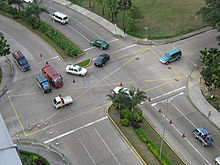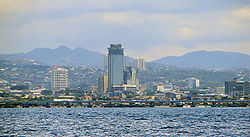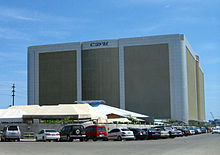- Metro Cebu
-
For the article on the Province of Cebu, see Cebu. For its capital city, see Cebu City. For other uses, see Cebu (disambiguation).
Metropolitan Cebu — Metropolis — Skyline of Metro Cebu Nickname(s): Metro Cebu Political map of Metro Cebu Coordinates: 10°17′N 123°54′E / 10.283°N 123.9°ECoordinates: 10°17′N 123°54′E / 10.283°N 123.9°E Country Philippines Region Central Visayas
(Region VII)Province Cebu Population (2007) - Total 2,314,897 Metro Cebu is the main urban center of the province of Cebu in the Philippines. Metro Cebu is located along the central eastern portion of the island including the nearby island of Mactan. It accounts for 20 percent of the land area and 60 percent of the population (2007 census) of the entire province of Cebu.
Metro Cebu is a metropolitan area that is located in Cebu City, the capital of Cebu and the regional center of Central Visayas with twelve surrounding cities and municipalities.
The Metropolitan Cebu Development Council (MCDC) is a body mandated to formulate development plans for the Metro Cebu area and coordinate their implementation. Unlike the Metro Manila Development Authority, the MCDC does not have legal and institutional powers.
Contents
Cities and municipalities
METRO CEBU comprises seven cities and six municipalities.
Local government unit Population¹ Area (km²) Pop. density (per km²)
Carcar City 100,632 116.78 862 Cebu City 822,628 315.0 2,536 Compostela 39,167 53.90 727 Consolacion 87,544 147.20 595 Cordova 45,066 17.15 2,628 Danao City 109,354 107.30 1,019 Lapu-Lapu City 292,530 58.10 5,035 Liloan 92,181 45.92 2,007 Mandaue City 346693 25.18 12,652 Minglanilla 101,585 65.60 1,549 Naga City 95,163 101.97 933 San Fernando 54,932 69.39 792 Talisay City 179,359 39.87 4,499 Total 2,357,461 1163.36 1,990 ¹2007 Census
Note: In October 2005, development planners from Regional Development Council 7, Metropolitan Cebu Development Council headed by the Cebu Provincial Governor and Local Government Units of Cebu expanded the definition of Metro Cebu to include the cities of Carcar and Danao, and the municipality of San Fernando[1].[2]The provincial capitol, the central business district, major educational institutions and the international port are all located in Cebu City while major industrial companies and factories are located in Mandaue. The international airport and the export processing zone are located in Lapu-Lapu in Mactan Island. Danao is primarily a mining city while Talisay is a residential city with its income generated by small and medium sized businesses.


Panoramic view of Metro Cebu History
Cebu City was a fishing village and farming settlement governed by Visayan native chieftains who traded with the neighboring islands of Malaysia and Indonesia.
On April 7, 1521, Portuguese explorer Ferdinand Magellan arrived in Cebu. Magellan failed to successfully claim the Philippines for the crown of Spain as he was slain on Mactan Island on April 27, 1521 by its chieftain Datu Lapu-lapu.
On April 27, 1565, Spanish explorers led by Miguel López de Legazpi arrived in Cebu. The Spaniards renamed the city on January 1, 1571, from San Miguel (Saint Michael) to Villa del Santissimo Nombre de Jesús (Town of the Most Holy Name of Jesus). The island were a former capital city of the Spanish East Indies before the capital city was moved to Manila in 1571.
Mandaue City then was known as Mandani ruled by her chieftain Aponoan. She was formally constituted into a "pueblo" (people) between 1580 to 1700 and was officially known as the Población de Mandaue (Town of Mandaue) in 1899. It emerged into the industrial city of Mandaue. Mandaue became a chartered city on June 21, 1969 through Republic Act 5519. It was considered a highly-urbanized city in the year 1991.
The City of Talisay was a former Augustinian order hacienda (estate) in 1648 and became a municipality in 1849. On December 30, 2000, Talisay became a component city by virtue of Republic Act 8979.
Lapu-Lapu City was originally referred to as "Mactan." It later became the town of Opon in 1730, the 7th town founded by the Augustinian Friars in Cebu. The town of Opon became a city on June 17, 1961. It largest district, Lapu-Lapu City, was named after Datu Lapu-Lapu.
Metropolitan Cebu was conceptualized by government planners in the 1970s and was based on experiences of urban planning in Metro Manila. Metro Cebu represented the province's thriving urban centers that are physically proximate to Cebu City which is the leading commercial and financial hub in the Visayas and northern Mindanao areas with a population largely dependent on the economic opportunities prevailing in the area.
People
Ancestry
The people of Cebu are called Cebuanos. Some individuals have European, Chinese and other foreign ancestries as well as ancestries from other Filipino ethnic groups.
Languages
Cebuano and English are spoken in Metro Cebu. English is commonly used in educational institutions and business transactions. Other languages spoken include Chinese, Spanish, and a range of Visayan languages.
Education
Metro Cebu is the seat of well-known and highly-regarded educational institutions in the country.
These includes:
- University of San Carlos (1595)
- University of San Jose–Recoletos (1947)
- University of the Philippines Cebu College (1918)
- Cebu Normal University (1915)
Other note-worthy universities and colleges include:
- Cebu Doctors' University (1975)
- Southwestern University (1946)
- University of Cebu (1964)
- University of the Visayas (1919)
- Velez College (1957)
- Cebu Institute of Technology – University (1946)
- University of Southern Philippines Foundation (1927)
- Don Bosco Technology Center (1954)
- Asian College of Technology (1988)
- Cebu Technological University (CTU) (1911)
- Cebu Eastern College (1915)
A large number of students from the neighboring provinces such as Bohol and Misamis Oriental to name a few, prefer to go to Metro Cebu to take up tertiary-level education.There is also a sizable number of South Korean and Iranian students who take up tertiary-level courses in Metro Cebu. Most of these Koreans came here to learn the basics of conversational English while the majority these Iranians study Medicine and other medical-related courses.
Cebu has two internationally-connected educational institutions. They are: the Cebu International School, which is located in Sitio Pit-os, Barangay Talamban, and the Center for International Education (CIE), which is a secondary-level educational institution offering some tertiary-level courses.
Events
2004 presidential inauguration
 Arroyo taking her Oath of Office in Cebu City on June 30, 2004
Arroyo taking her Oath of Office in Cebu City on June 30, 2004
On June 30, 2004, Gloria Macapagal-Arroyo was the first Philippine President to be inaugurated in Metro Cebu. The inauguration was done in front of Cebu Provincial Capitol in Cebu City. This was done in gratitude for the support given to her by the people of Cebu during the election. In a break with tradition, she delivered her inaugural address in Manila before departing for Cebu for her inauguration.
2005 Southeast Asian Games
Metro Cebu and other key Philippine cities hosted the 2005 Southeast Asian Games. The event was held from November 27 to December 5, 2005. Venues for this event includes the Cebu City Sports Complex, Cebu Coliseum, Mandaue Coliseum, University of San Carlos and parts of Danao City.
2006 ASEAN Summit and 2nd East Asia Summit
The 12th Summit of the Association of Southeast Asian Nations (ASEAN), originally scheduled for Dec. 10-14 was postponed to January 2007 due to Typhoon Utor. The decision was made in consideration of the safety and welfare of the participants. [2]
The Cebu International Convention Center is a structure built by the Cebu provincial government in time for the 12th ASEAN Summit and 2nd East Asia Summit at a cost of around US$10-million dollars, US$5-million dollars more than expected. It is a three-storey structure with a total floor area of 25,000 square meters and situated on 3.8 hectares of land at the Mandaue City Reclamation Area.
Public utilities
Communication
Philippine Long Distance Telephone Company (PLDT) is the major phone carrier in the metropolis and the entire province. Globelines Innove and Islacom, both subsidiaries of Globe Telecom came in after the passage of the Telecommunications Act of 1995.
There are three wireless telecommunication companies serving Metro Cebu as well as the rest of the Philippines. These are:
- Smart Communications/Pilipino Telecommunications Corp., a PLDT subsidiary — using the brands: Smart, Talk 'n' Text, and Addict Mobile
- Globe Telecom — using the brands: Globe and TM
- Digitel Mobile — using the brand Sun Cellular
Electricity
Metro Cebu's electricity is mostly supplied from Leyte Geothermal Power Plants operated by PNOC-EDC which is interconnected across Cebu through electrical submarine cables operated by TransCo. It is transmitted by the state-owned National Transmission Corporation (TransCo) through several high tension wires. It is stored and distributed by the Visayan Electric Company. They put out 220VAC 50 Hz (VECO).
 SM City Cebu, the largest SM mall outside Metro Manila
SM City Cebu, the largest SM mall outside Metro Manila
Water
In 1974 the Metropolitan Cebu Water District (MCWD) took over in distributing potable water to the whole metropolis after the Osmena Waterworks System suffered financial losses. MCWD supplies potable water to the cities of Cebu, Mandaue, Lapu-lapu and Talisay and the municipalities of Consolacion, Lilo-an, Compostela and Cordova from their reservoirs in Talamban and Pardo in Cebu City, Casili in Consolacion and Mananga in Talisay City.
Water shortage has always been a problem in Metro Cebu due to deforestation and seawater intrusion of the underground water supply.[3] There was a proposal to acquire water from nearby Bohol island because of the water crisis in the metropolis. [3]
In 1998, the Mananga Phase I Project located in Talisay City was completed producing an additional 33,000 cu.m or 33 million liters of potable water per day.
Transportation
See also: Transportation in the PhilippinesRoads
 An intersection within Cebu Business Park
An intersection within Cebu Business Park
Metro Cebu's roadways are among the country's busiest. The south highway, Osmena Boulevard, Colon, and V. Rama are Metro Cebu's major roads. A new highway which is the South Coastal Road or the Cebu Coastal Road is almost complete. The 12 kilometer, 4-lane highway was created to improve traffic in Metro Cebu. It connects Cebu City, Talisay City and other southern municipalities. In conjunction with the development of the Cebu South Coastal Road, a roadway underpass nearly a kilometer long is currently under construction to connect the South Coastal Road with the Sergio Osmeña Avenue in the North Reclamation Area. Other planned projects include a series of flyovers in the north district, the Cebu North Coastal Road and Cloverleaf interlink road project.
The resort island of Mactan is connected to the island of Cebu via two bridges. The Marcelo Fernan Bridge and the, much older, Mactan-Mandaue Bridge. A 3rd Cebu-Mactan link is being proposed by the local leaders of Cebu City and Lapu-Lapu, citing the growing inconveniences related to the existing two steel bridges. It has not yet been decided what mode this link would be (an undersea-tunnel or a bridge).
Airport
Mactan Cebu International Airport (MCIA) is, officially, the only international airport in the Visayas and the only airport in the Metro Cebu. Located in Lapu-Lapu City, it is the second busiest airport in the Philippines, after Metro Manila's Ninoy Aquino International Airport. It also doubles as the Mactan-Benito Ebuen Air Base.
Its current terminal complex is capable of handling and serving 3.5 - 4.0 million air passengers annually.
The number of weekly international flights to and from MCIA has constantly increased over the years. Currently, there are direct regular and/or charter flights to the following international destinations: Singapore, Hong Kong, Tokyo-Narita, Seoul-Incheon, Busan,and Doha.
Metro Cebu's MCIA is the international gateway to the economic hub of the Central and Southern Philippines. There are numerous daily flights between Cebu and most Philippine cities. Air freight to and from Cebu is reliable and efficient with major international couriers like FedEx, Fastpak Global Express, and 2GO operating here.
A new terminal has been proposed. This planned terminal will only be used by airlines flying international routes to/from MCIA.
Seaport
Metro Cebu's Port of Cebu is the second busiest seaport in the Philippines. Along with the ports areas of Mandaue and Lapu-Lapu, Cebu's "seaport complex" is considered as the busiest port in the Philippines in terms of number of annual passengers. It is also the main port of entry in the province of Cebu and Central Visayas Region. It plays a vital role in the Philippine's shipping industry with about 80 percent of the country's shipping companies that are based here. The port is located at the center of the province's east coast. It is nestled in a natural harbor in the narrow strait between Cebu City and Mactan Island, the latter providing a natural cover and breakwater, making the port one of the safest and operational the whole year round.
Cebu International Port and Cebu Domestic Port serves container vessels and passenger ships with destinations around the country and the world. Cebu International Port is a multipurpose terminal covering an area of 10 hectares with 690 meters of berthing space and a controlling draught of minus 8.5 meters at MLLW. The Cebu Baseport — Domestic Zone is the area for the domestic transactions of different business coming from and going to the different island of the archipelago. It is dedicated to coastwise shipping with 3.5 kilometers of berthing space, 3 finger piers and 3 passenger terminals.
Metropolitan Cebu Development Council
The Metropolitan Cebu Development Council was created by the RDC through Resolution No.117 (1997) and was patterned after the Metropolitan Manila Development Authority. It is mandated to formulate development plans, prepare programs and projects, and coordinate/monitor the implementation of programs and projects that address problems and concerns affecting Metro Cebu.
The MCDC is composed of the Provincial Governor of Cebu; the Mayors of the Cities of Cebu, Mandaue, Lapulapu and Talisay; and the Mayors of the Municipalities of Compostela, Liloan, Consolacion, Cordova, Minglanilla and Naga. The Governor of Cebu acts as Interim Chairman of the Council.
In August 2005, the Regional Development Council (RDC 7) of Central Visayas, composed of all the governors of Region VII, the Metropolitan Cebu Development Council headed by the Cebu Provincial Governor and Local Government Units of Metro Cebu expanded the definition of Metro Cebu to include the towns of San Fernando and Carcar City in the south and Danao City in the north [4].
Member-LGUs of the MCDC believe the commercial and industrial area of Cebu has already expanded to the towns of San Fernando and Carcar City and to Danao City.
MCDC does not have legal and institutional powers and resources like the Metropolitan Manila Development Authority (MMDA). The MCDC defines the coverage of Metro Cebu for planning purposes only. The Province of Cebu has proposed a bill to create a permanent Metropolitan Cebu Development Authority (MCDA). This bill is still pending in both the House of Representatives and Senate in he Congress of the Philippines.[4]
References
- ^ RDC enlarges Metro Cebu - Sun. Star Cebu, October 8, 2005
- ^ Official Website of the Municipality of San Fernando Cebu
- ^ Protection of the water supply of metropolis Cebu in consideration of the saline intrusion [1]
- ^ NEDA RDC7 Accomplishment Report(7/2001 - 12/2002)
External links
Cities Municipalities Component local government units of Cebu Municipalities Alcantara • Alcoy • Alegria • Aloguinsan • Argao • Asturias • Badian • Balamban • Bantayan • Barili • Boljoon • Borbon • Carmen • Catmon • Compostela • Consolacion • Cordova • Daanbantayan • Dalaguete • Dumanjug • Ginatilan • Liloan • Madridejos • Malabuyoc • Medellin • Minglanilla • Moalboal • Oslob • Pilar • Pinamungahan • Poro • Ronda • Samboan • San Fernando • San Francisco • San Remigio • Santa Fe • Santander • Sibonga • Sogod • Tabogon • Tabuelan • Tuburan • TudelaComponent cities Highly urbanized cities (Administratively independent from the province, but grouped under Cebu by the National Statistics Office)Angeles • Bacolod • Baguio • Batangas • Cagayan de Oro • Cebu • Dagupan • Davao • Iloilo-Guimaras • Manila • Naga • OlongapoCategories:- Metropolitan areas of the Philippines
- Metro Cebu
- Visayas
Wikimedia Foundation. 2010.







